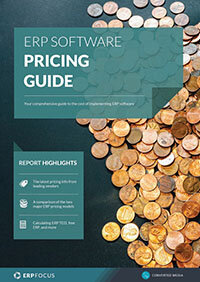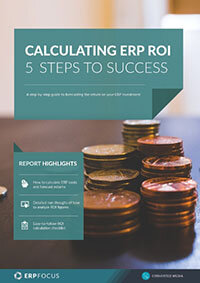Calculating ERP implementation costs of top ERP systems
When you’re considering which ERP system to go with, you need to get the full picture on pricing. The license fee is just one part of the expenditure. To ensure your software investment delivers value, you need to consider all the moving parts that make an ERP project successful. And that means planning the full project scope budget with your eyes wide open. A Software Path report stated that the average budget per user for an ERP project is $7,200, but this number varies depending on business size and number of users.
In this guide, we’ll run through the implementation costs to look out for and how to get a handle on implementation costs.
How much does it cost to implement an ERP system?
When purchasing ERP, small businesses spend $7,143 per user, mid-sized businesses spend $8,542 per user, and large businesses spend $7,257 per user.
This cost is over a 5 year period meaning a mid-sized business with 100 users would be looking to pay $170,840 per year for their ERP system - including the cost of the system itself and the implementation costs.
How much of your ERP budget should be allocated to implementation?
As a (very broad) rule, the cost of Enterprise Resource Planning software can be between 100% and 200% of the license fee. The software license itself is also a moving target. You could be looking at a perpetual license or a subscription. That license fee can be affected by a number of factors. And so, searching for prices online can be very tricky -- I feel your pain because I’ve been doing just that!
For more advice on ERP costs check out our free ERP budget guide
Because there is no one-size-fits-all in ERP software, I’m going to give you the best starting point so that you know what to ask the vendors. I hope this will help you avoid the danger of missing an important factor while giving you the right questions to take to vendors.
Back to that seemingly large implementation figure of up to 200%... why does it cost so much to roll out an ERP system? For starters, you need to think of the license as just one piece of a much bigger project. The total cost of ERP implementation will include some (or even all) of the following elements depending on your requirements:
- License fees
- User numbers
- Training
- Features and modules
- Customization
- App integrations
- Data migrations
- Training
- Testing
- Maintenance plans
- Upgrades
Let’s take a deeper look at some of these ERP implementation considerations to help you weigh up the costs for your specific needs.
The top ERP implementation costs to consider
This is where your prep work comes in. If you haven’t created a requirements checklist yet, start there. Then you can begin to unwrap the implementation costs that apply to your unique business goals.
ERP user numbers
The number of users is one of the biggest factors impacting your ERP implementation cost estimate. But make sure your chosen range works alongside your growth plans. If you’re expecting to make significant hires in the next few years, check with each vendor on your shortlist which is the most cost-effective route. If you have a large user database from the outset, some ERPs will have a higher license fee to match. While others will give you a lower initial fee but might have a higher rate for adding users later.
The lesser recognized user-based cost is that more people often means you’ll need more customization ― and a bigger training effort to make sure each user group gets the support they need to succeed.
ERP architecture options
When selecting the right ERP for your business, you’ll be faced with all-in-one solutions, out-of-the-box modules, and bundles of features. On top of that, you’ll have vendors offering to build custom features for you.
Sometimes it looks like you’re getting more for your money when you get an ‘all-in-one’ ERP. Dazzled by the tools you didn’t even consider previously, it’s easy to over-buy and overrun your budget. Equally, if you buy a system that requires multiple add-ons and customizations now (or in the near future), you can find yourself sinking cash into the wrong product to bring it up to scratch.
In-house vs 3rd party implementation
In most cases, you’ll want to engage a 3rd party to implement your ERP. While some businesses have a very adept in-house team and may choose an out-of-the-box solution. This can make it viable to handle the project internally. However, there is still a cost involved with using your own IT specialists as other key projects and BAU IT services have to be managed somehow. It can also mean a slower rollout and be more prone to error.
In most mid and large-sized businesses, it makes sense to use a 3rd party with experience in ERP implementations, integrations and processes. The more complex your organization, the more useful it is to engage a specialist familiar with your chosen ERP system. In the “Market Share Analysis: ERP Software, Worldwide, 2016” report from Gartner, it’s noted that using open API standards could lead to inconsistencies in integrations unless strong data management and a strict governance policy are in place.
How to get ERP implementation cost estimates
While it’s not easy to get prices together without speaking directly to vendors, there are some early clues to look out for. Here are some examples of how top ERPs are priced and how that could inform your implementation budget. Remember to expect implementation to cost at least 100% of the ERP itself.
NetSuite ERP pricing

Pricing based on users, modules, and add-ons. To get a quote based on your needs, you’ll need to contact the vendor directly. Be ready with your requirements checklist to get the most accurate figure.
SYSPRO pricing

Pricing by quote. Syspro’s pricing is based on multiple variants, including user numbers, deployment, and specific feature requirements.
Oracle ERP pricing

Pricing based on feature bundle. Oracle ERP Cloud has three pricing tiers:
- Financial Reporting plan - $175/month.
- Advanced Financial Controls - $80 per user per month
- Advance Access Controls package - $150/user per month.
SAP S/4HANA

Priced by deployment. SAP ERP pricing isn’t made public. To get a quote, you have to visit the vendor’s website. The type of deployment you need will dictate your plan and the pricing.
Check out our ERP pricing guide for more in-depth pricing information on over 40 top ERP systems
Next steps: what to consider when comparing costs of ERP implementation
You can’t begin calculating costs before you know what you’re buying. To calculate implementation costs, you need to:
- Elect a team leader to head up your steering committee and build a team to help with the key decisions
- Create a requirements list (features, integrations, users, cloud or on-premise)
- Send out an RFI to the vendors you feel are the best fit
- Shortlist the vendors and request proposals
- Discuss implementation costs with each vendor and ask for case studies similar to your own business
- Consider whether you can handle the implementation in-house or need vendor/ 3rd party project management
Once you have defined the project scope and shortlisted the ERPs that best solve your business challenges. You’ll be ready to ask the right questions about ERP implementation. If you need guidance on getting to that point, read our ERP Buyer’s Guide.
Free white paper

ERP Software Pricing Guide
Get the latest pricing information on over 80 popular ERP systems, and learn how to budget for your ERP project in our free guide

Featured white papers
-

ERP Software Pricing Guide
Get the latest pricing information on over 80 popular ERP systems, and learn how to budget for your ERP project in our free guide
Download -

ERP Implementation: 9 steps to success
The 9 proven steps you should follow when implementing ERP
Download -

Calculating ERP ROI: 5 steps to success
Calculate your new ERP's financial benefits with this comprehensive guide
Download
Related articles
-

The case for multi-tier ERP implementations
Learn more about multi-tier ERP implementation and why you might need one
-

CMMC Compliance: What Aerospace and Defense Manufacturers Need to Know
Key insights on CMMC compliance, deadlines, and securing DoD contracts with CMMC 2.0 certificatio...
-

An example ERP implementation team structure for your project
Learn about three key elements of an ERP implementation team and the individuals who contribute w...

